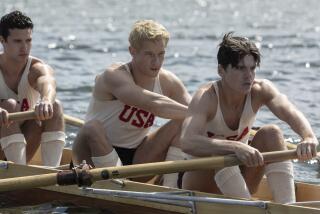Whitbread Is a Test Too Great to Ignore
- Share via
SOUTHAMPTON, England — Until now, Josh Belsky of Rye, N.Y., has been the typical American sailor who does a race, then goes ashore to sleep in a bed at night.
He’ll miss that and a few other amenities as the Whitbread Round-the-World Race grinds through the next eight months.
“French fries,” Belsky said. “And my truck. I’ll miss my truck.”
Most American sailors sail around buoys, not Cape Horn, but while the forecast for southern England calls for a balmy day, and when the race starts today, they aren’t likely to be lulled into a false sense of security. They have heard the horror stories and the accompanying machismo: “Real men sail the Whitbread.”
Said Steve Erickson: “I feel we need to prove something for Americans. Europeans and Kiwis have had a monopoly on this for too long.”
The U.S., which has had only four boats in the previous six races, has three of the 10 this time, plus Sweden’s EF Language--most boats are named for their sponsors--which has San Francisco’s Paul Cayard as skipper and five other Americans, including Belsky and Erickson, as crewmen.
Curiously, that’s one more Yank than all three of the U.S. entries combined. George Collins’ Chessie from the Chesapeake Bay has only five, and Dennis Conner’s Toshiba and Neil Barth’s America’s Challenge from Newport Beach won’t have any when the owners aren’t aboard, which will be most of the time.
In its evolution from a quixotic adventure for amateurs, the Whitbread has become a relentless charge for fearless young, strong, hard-driving professionals on high-tech boats, the Whitbread 60s.
Collins, 57, recently retired as CEO of a Baltimore investment-management company to pursue his passion for sailing. But on the Atlantic crossing and in the three-day Fastnet Race, alongside co-skipper Jim Allsopp, 50, he found he was in over his head and replaced himself with someone 30 years younger.
“We needed to strengthen the crew,” Collins said. “We learned you can’t put two 50-year-olds on the boat at the same time. It’s too much of a strain on the rest of the crew.”
Conner and Barth hired veteran New Zealand skippers--Chris Dickson on Toshiba and Ross Field on America’s Challenge--and they hand-picked mostly Kiwi crews, Whitbread experience being in short supply stateside.
Conner, 55, doesn’t think it matters.
“It’s not an American deal,” he said. “It’s not America versus the rest of the world. It’s an international race.”
It’s also a killer.
“Dodging icebergs that you can’t even see on your radar at 30 knots--it’s stupid,” Conner said. “I think it’s the most dangerous sailing there is. Kids, they don’t think anything’s gonna happen to them.”
Conner’s boat is among the favorites, but nobody is dismissing Barth’s America’s Challenge despite--or because of--its late arrival and its departure in design from the Bruce Farr boats. Farr-designed boats have dominated recent Whitbreads and all but one rival, the Dutch, are sailing them this time.
More to Read
Sign up for The Wild
We’ll help you find the best places to hike, bike and run, as well as the perfect silent spots for meditation and yoga.
You may occasionally receive promotional content from the Los Angeles Times.






